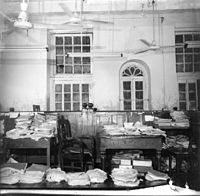Revolutionary movement for Indian independence
The Revolutionary movement for Indian Independence was part of the Indian independence movement comprising the actions of violent underground revolutionary factions. Groups believing in armed revolution against the ruling British fall into this category, as opposed to the generally peaceful civil disobedience movement spearheaded by Mahatma Gandhi.
Apart from a few stray incidents, the armed rebellion against the British rulers was not organised before the beginning of the 20th century. The revolutionary philosophies and movement made their presence felt during the 1905 partition of Bengal. Arguably, the initial steps to organise the revolutionaries were taken by Aurobindo Ghosh, his brother Barin Ghosh, Bhupendranath Datta, Lal Bal Pal and Subodh Chandra Mullick, when they formed the Jugantar party in April 1906.[1] Jugantar was created as an inner circle of the Anushilan Samiti, which was already present in Bengal, mainly as a fitness club. The notion of self-improvement of the public along lines of physical, intellectual and spiritual development followed from ideas propagated by thinkers such as Bankim Chandra Chattopadhyay, Swami Vivekananda and Sri Aurobindo who were rooted in Shakta Hinduism. [2]
Andhra Pradesh[edit]
Uyyalawada Narasimha Reddy (died 22 February 1847) was the son of a former Indian Telugu polygar who was at the heart of a rebellion in 1846, when 5000 peasants rose up against the British East India Company (EIC) in Kurnool district, Rayalaseema Region of Andhra Pradesh. They were protesting changes to the traditional agrarian system the British introduced in the first half of the nineteenth century. Those changes, which included the introduction of the ryotwari system and other attempts to maximize revenue, impacted lower-status cultivators by depleting their crops and leaving them impoverished.
Maharashtra[edit]
[edit]
The Abhinav Bharat Society (Young India Society) was a secret society founded by Vinayak Damodar Savarkar and his brother Ganesh Damodar Savarkar
in 1904.[9] Initially founded at Nasik as "Mitra Mela" when Vinayak Savarkar was still a student of Fergusson College at Pune, the society grew to include several hundred revolutionaries and political activists with branches in various parts of India, extending to London after Savarkar went to study law. It carried out a few assassinations of British officials, after which the Savarkar brothers were convicted and imprisoned. The society was formally disbanded in 1952.[10][11]
Savarkar's revolutionary propaganda led to the assassination of Lt. Col. William Curzon-Wyllie, the political aide-de-camp to the Secretary of State for India, by Madanlal Dhingra on the evening of 1 July 1909, at a meeting of Indian students in the Imperial Institute in London. Dhingra was arrested and later tried and executed. A. M. T. Jackson, the district magistrate of Nasik, was assassinated in India by Anant Laxman Kanhare in 1909 in the historic "Nasik Conspiracy Case".[12][13]
The investigation into the Jackson assassination revealed the existence of the Abhinav Bharat Society and the role of the Savarkar brothers in leading it. Vinayak Savarkar was found to have dispatched twenty Browning pistols to India, one of which was used in the Jackson assassination. He was charged in the Jackson murder and sentenced to "transportation" for life. Savarkar was imprisoned in the Cellular Jail in the Andaman Islands in 1910.[12]
Kotwal Dasta[edit]
Veer Bhai Kotwal alias Veer Bhai Kotwal during Quit India Movement formed group of underground mercenaries called "Kotwal Dasta", a parallel government in the Karjat taluka of Thane district. They were about 50 in numbers including farmers and voluntary school teachers. They decided to cut down the electric pylons supplying electricity to Mumbai city. From September 1942 through November 1942 they felled 11 pylons, paralyzing the industries and railways.






